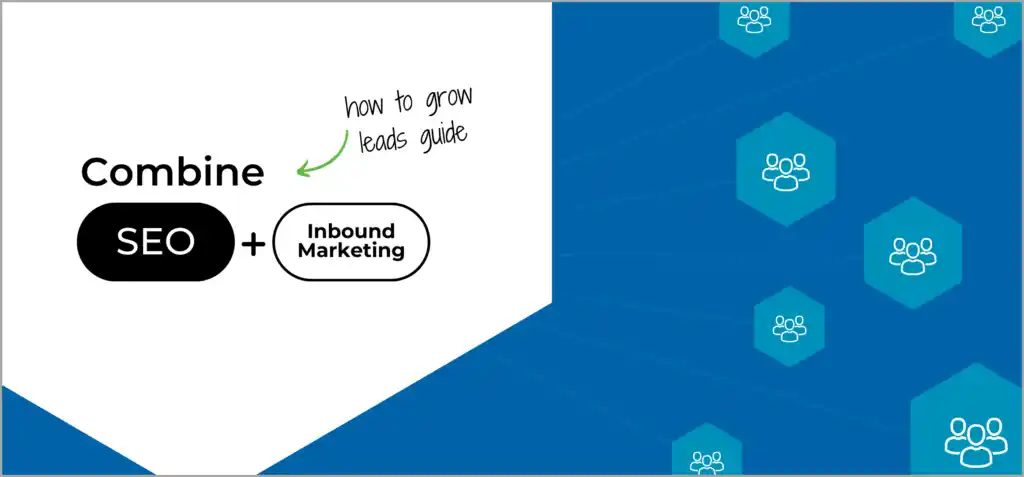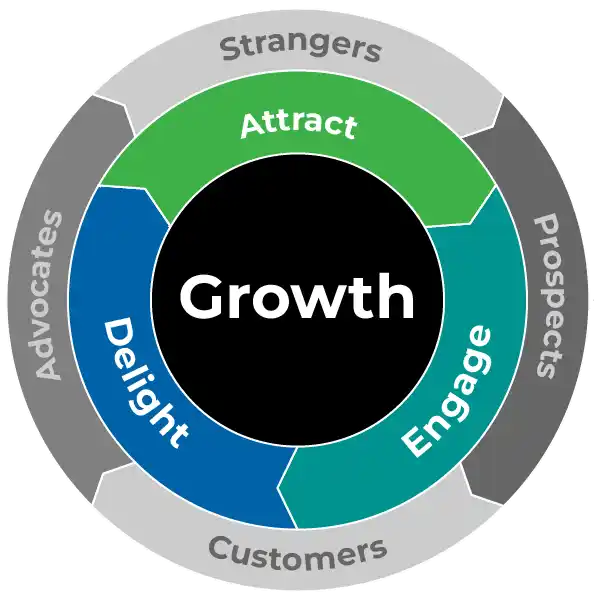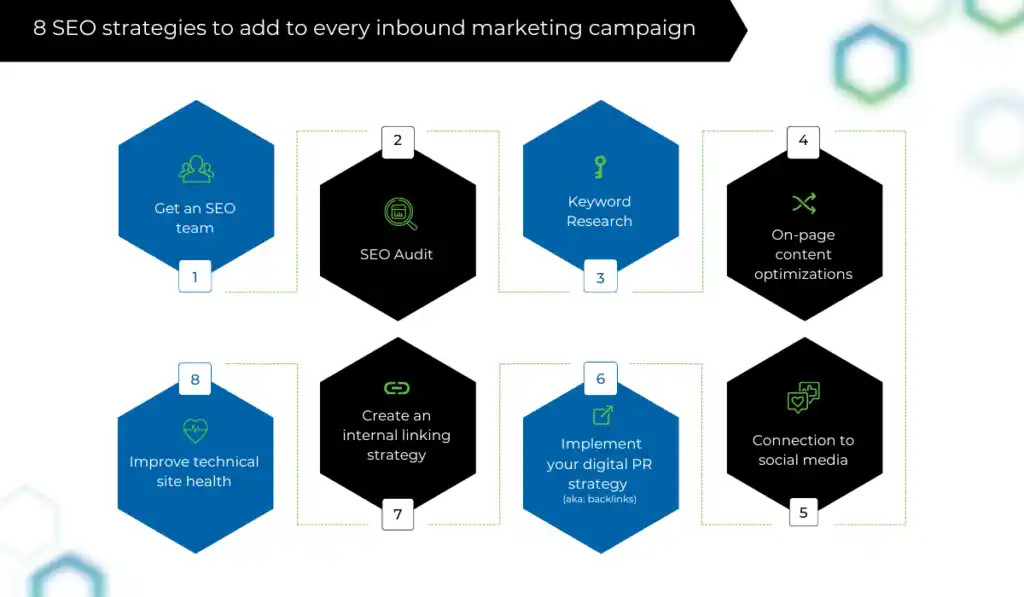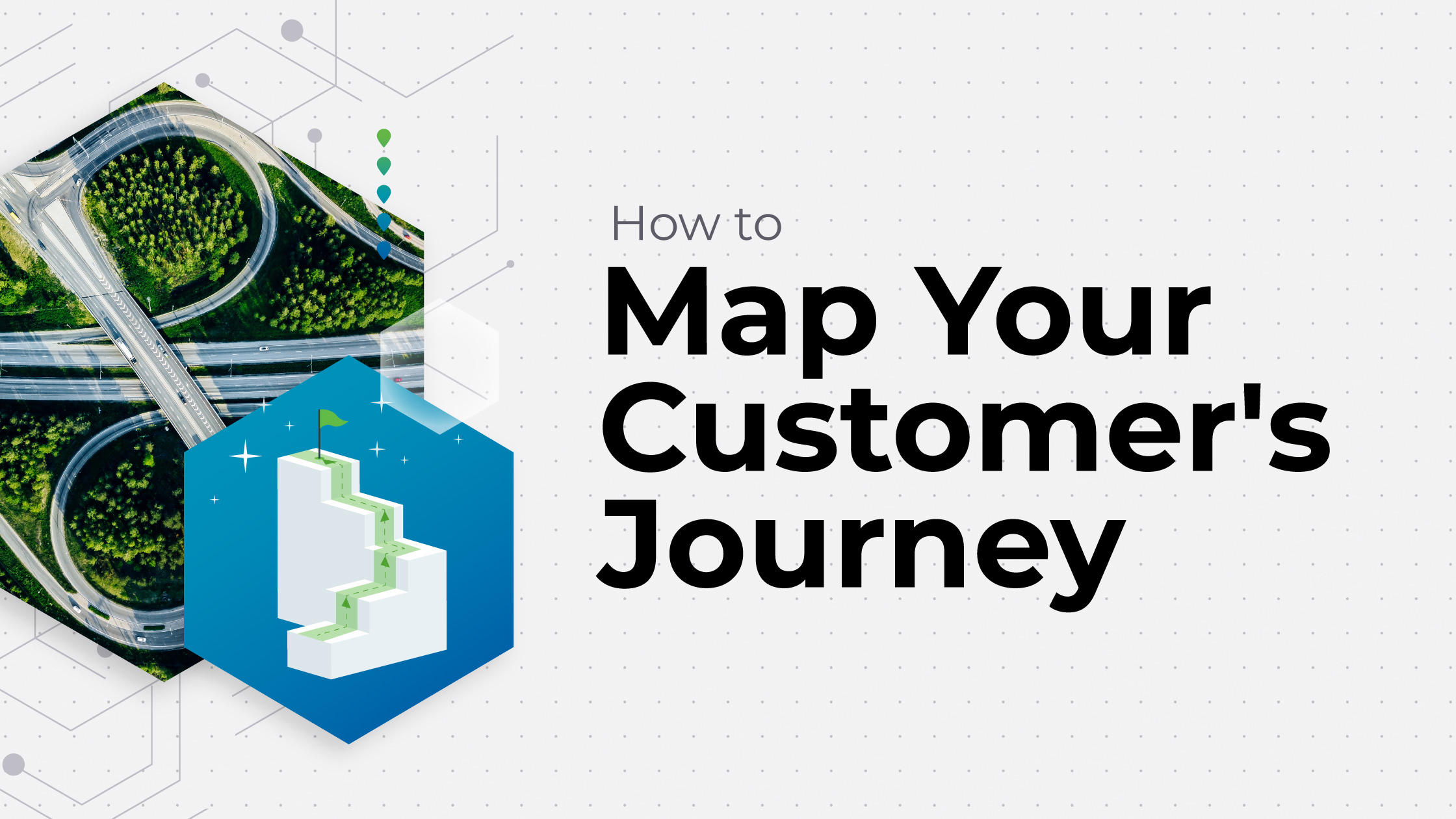
Even though SEO has been around for over two decades, most brands are still producing digital marketing content that’s not optimized for search engines.
This is doubly true for businesses that use inbound marketing to grow their lead and customer base.
But if those first two paragraphs describe your brand to a tee, don’t panic!
Turns out, SEO and inbound marketing best practices are very much aligned, so enhancing your content strategies to produce high quality SEO content that supports an effective inbound strategy (and vice versa – they amplify each other) isn’t as complicated as you might think.
What is inbound marketing?
Inbound marketing is a growth strategy that focuses on attracting customers by offering them relevant, helpful content and engaging online experiences.
The goal of inbound marketing is to get potential customers to come to you, rather than interrupting them with traditional marketing tactics like advertising. Because that feeling of finding the perfect YouTube video, only to be forced into 15 seconds of completely irrelevant content as the cost-of-entry…
Sure, that 15-second spot could be a valuable touchpoint for your brand, but you’re running the risk of alienating some consumers with content that’s significantly disconnected from their search intent. Inbound marketing is adamant about never taking that risk.

Inbound marketing typically involves the following steps:
- Attract visitors to your website through content marketing, social media marketing, SEO and other tactics, including paid.
- Engage visitors by offering valuable and relevant content, addressing their intention, need or pain point.
- Convert visitors into marketing inquiries (sometimes called leads, but we like to refrain from that until the visitor is qualified) by providing a way for them to share their contact information via form fills, newsletter sign ups, or a good ol’ fashioned contact page.
- Nurture inquiring visitors with customized, automated emails and other engaging forms of communication, helping them move further down the sales funnel (from MQI, to MQL, then SQL and customer!).
- Delight your customers by providing excellent service and ongoing support, helping to build long-term relationships, brand loyalty, and brand advocacy.
Inbound marketing focuses first on providing leads value before shifting into promoting your products or services. This can also be a highly effective way of building brand awareness and credibility.
So what’s the connection between inbound marketing and SEO? We’re getting to that.
First, here’s a quick refresher:
What is SEO?
SEO stands for search engine optimization. SEO is a set of strategic, technical, and content optimizations that seek to improve a website’s position in search engine results pages (SERPs). The main benefits of good SEO are:
- Improved visibility. With higher SERPs and keyword rankings, your website is more visible to potential customers, which subsequently increases the amount of traffic coming to your site.
- Better and more traffic. One of the most essential SEO practices involves optimizing your site content with keywords that have specific relevance to your product and its ideal customer base. A well-optimized site attracts more targeted traffic, which makes those users far more likely to move down the funnel toward acquisition.
- Cost savings. Typically, SEO tools and expert SEO consultants are significantly less expensive than paid media alternatives like PPC advertising.
Incorporating SEO into your inbound marketing strategy
Inbound marketing and SEO can (and should!) be used together to effectively attract and engage new business. Not doing so is a massive missed opportunity.
Particularly for brands practicing inbound marketing, your content team is already investing significant hours and resources in the name of creating content that your target audience will find valuable and interesting.
By making just a few adjustments to your team’s workflow, you could optimize that content for both increased inbound marketing effectiveness (lead capture and personalization) and search engine ranking improvements.
The crucial Google context that underpins all SEO and inbound marketing success
Any conversation about SEO has to start with Core Web Vitals (CWV). Here’s what you really need to understand about this “major service pack update” to the Google algorithms:
- CWV first landed in 2021, but continues to be tinkered with, even as recently as Jan 2023. You need SEO experts who are on top of every update.
- CWV is Google’s way of saying that a site’s technical health and the resulting user experience that it delivers, will significantly impact how your content ranks. Page speed is at the top of the CWV list of priorities.
- CWV does NOT apply only to organic search. The quality of the product Google puts in front of its users is critical to Google’s success, which is why paid media will also struggle to gain ground if your site is failing Core Web Vitals. The algorithm is designed to suppress traffic to paid campaigns whose corresponding landing pages and sites offer a subpar experience for users.
8 SEO strategies to add to every inbound marketing campaign
1. Get an SEO team
(Is resourcing a strategy? Is that a stretch? Even if it is, we still need to start there.)
SEO is not a one-person job. You need technical expertise and content pros working in collaboration. And nope, that nice-looking SEO plug-in is not robust enough.
SEO professionals are experts in optimizing both your evergreen website content, campaign-specific content, and the backend source code of your website that’s talking to Google.
2. SEO audit
Before diving into a new campaign, we suggest taking a step back and assessing your starting point with a highly-contextual SEO audit. This will reveal immediate technical and content optimizations that pave the way for improved performance across the board.
3. Keyword research
Apiary practices data-driven SEO implementations that intentionally target users who are already searching for content related to your product/inbound marketing campaigns. This requires thorough keyword research and competitor analysis.
- Conduct competitor research to see what keywords are performing well in your industry. This will highlight keyword gap opportunities you can capitalize on.
- Define the keywords you want to target based on product goals, search volume, and keyword difficulty.
- Identify target phrases and the search intent associated with those phrases.
4. On-page content optimizations
After mapping the priority keywords defined in your keyword research to existing URLs or the net new URLs that you’ll be using in your inbound marketing activities, you’re now ready to optimize the content on those pages.
- Optimize page title, metadata and body copy.
- Consider restructuring or replacing the content type you’ve chosen in order to align with the searcher intent associated with that target keyword/phrase.
5. Improve the technical health of your site
The most important job of technical SEO is to ensure that Google can crawl your website and understand your most valuable pages.
Most of the brands we meet aren’t aware of how significantly the technical health (or lack thereof) of their site is impacting performance, or how to fix it. This is where technical SEO expertise comes in with technical checks like:
- Confirm that all canonical tags are set up properly.
- Make sure your latest XML sitemap has been successfully submitted through Google Search Console.
- Ensure robot.txt file is set up properly.
- Confirm that your site is mobile-friendly across all device categories.
6. Create an internal linking strategy
Content that is linked to from multiple sources feeds Google a clearer picture of the interconnectedness and value of a piece of content. Internal links between your campaign and evergreen site content plus quality outbound links boosts the credibility and authority of your content in Google’s eyes.
- Add internal links that connect related pieces of content on your domain.
- Use keyword-rich anchor text in your internal links.
7. Implement your digital PR strategy (aka: backlinks)
Think of backlinks like a digital nod of approval. Google cares about the popularity of a piece of content, coupled with the quality of the sources linking to it.
If your inbound campaign includes any promotional collaborations, get that SEO juice by asking your partners to make sure that whenever they create content related to you/the campaign, they always include a link to your site.
8. Connection to social media
Driving qualified social traffic to your site is itself a backlink and increases the likelihood of getting even more backlinks and social shares, which will improve your content’s ranking on Google.
If your inbound marketing campaign doesn’t already utilize social media, we recommend revisiting this choice in order to promote your blog posts, webinars, ebooks, white papers, and engage with potential customers on these platforms.

SEO content is an opportunity to impress potential customers
There’s another aspect to SEO which syncs nicely with inbound marketing.
When you produce content, you’re able to demonstrate the depth of your knowledge on a particular topic. Subject matter expertise. This helps you build trust with your audience, which supports their purchasing decision when you serve up a call to action.
When Google ranks content, one of its primary goals is steering searchers to subject matter experts; websites that are specialists in their niche.
The more content you create on a given subject (high quality and well-optimized content), the more Google sees you as a subject matter expert and the more likely you are to rank highly for keyword phrases related to that subject. In the context of SEO, this is called topic authority (TA).
TA refers to a website’s level of expertise, authority, and trustworthiness on a particular topic. To enhance your TA in Google’s eyes:
- Create content that is well-researched, well-written and informative.
- Build backlinks from other reputable websites in your industry.
- Participate in industry forums and discussions to establish yourself as an expert in your field.
- Include relevant SEO keywords in your title tags and meta descriptions to help search engines understand the content of your website.
TL;DR summary of SEO & inbound marketing
- Inbound marketing is a growth strategy that focuses on providing leads with valuable content before asking for a sale.
- Search engine optimization is a process of strategic, technical, and content changes that improve how Google ranks your content in search engine results.
- SEO is heavily influenced by content, so inbound marketing content creation provides a ripe opportunity to apply SEO best practices and thereby improve organic search performance while implementing your inbound strategy
- Inbound marketing that doesn’t include SEO optimizations is a missed opportunity to maximize the value of your content and acquire as much organic (less expensive than paid media) traffic as possible.




